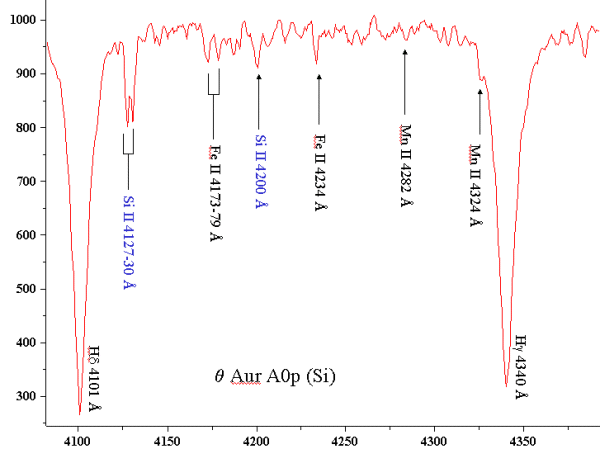PECULIAR STAR SPECTRA
A stars with abnormal abundancies of Si, Lanthanoids, Cr, Sr
The great spectroscopist W. Morgan, in 1935 wrote in his treatise on peculiar A stars:
"There is probably a greater diversity in appearance among the spectra of class A than in any
other type".
Infact about 25% of A stars show peculiarities. Anomalous abundances expecially concerns silicon, Lanthanoids (Europium,
Holmium, Dysprosium) and also Cromium and Strontium.
In 1946, using the 100 inches telescope of Mount Wilson, Horace Babcock first measured the magnetic field that is common to all
these stars and found values ranging from some thousand Gauss (Earth magnetic field is 0.3-0.6 Gauss) to the record of 34'000 Gauss
for silicon star HD215441.
This strong magnetic field is not present only in a class of peculiar hot A and B stars
that show strong Hg and Mn lines.
All the magnetic peculiar A stars are very slow rotators because of the magnetic braking effect and thus show very narrow spectral lines.
The strenght of spectral lines is often periodic and sincronous with variation of the magnetic field.
One of the stars where this variation is more evident is 73 Draconis.
Also the brightness undergoes small periodic variations. The first periodic Ap star discovered has been Cor Caroli in 1914, that shows a 0.05
variation in a 3 days period.

|
Picture 1: Spectrum of Ap(Si) star q Aur , with 0.6 ┼/pixel dispersion and 5 min exposure
(Cassegrain F/15 diam 60 cm) recorded on 4th April 2005. Strong ionized silicon lines are labeled blue.
|
Abundancies of anomalous elements is associated with ionisation temperature of the star. Silicon stars belong to late B or A0 class,
Lantanids and Cr rich stars are a bit colder and even colder are Sr stars that arrive to the F0 class.
The theory that better explains the behaviour of these stars is the oblique rotator. This means that a fixed magnetic field
rotates with the stars but misaligned with the rotation axis. Disomogenities of the chemical distribution on the surface are associated
with the emerging regions of the magnetic field and thus rotate with the same period of the star.
But many questions are still debated. Which is the origin of the magnetic field? Why these strange elements are associated with the field?
Some bright Ap stars are: q Aur (Si), a Cnv (EuSiCr), e Uma (CrEuMn),
n Aur (HoDy), b Crb (SrEuCr), 73 Draconis (righe Cr-Eu variabili con periodo di 20.7 giorni).
 Go back to peculiar stars home page Go back to peculiar stars home page
|
|
 Go back to peculiar stars home page
Go back to peculiar stars home page

